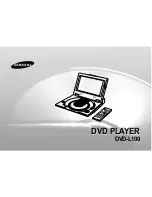
Glossary
Analog audio
Direct representation of sound by an electrical signal.
See also Digital audio.
Aspect ratio
The width of a TV screen relative to its height. Conven-
tional TVs are 4:3; widescreen models are 16:9.
Bonus Group (DVD-Audio only)
An “extra” group on some DVD-Audio discs that
requires a key number to access.
Browsable pictures (DVD-Audio only)
A feature of some DVD-Audio discs in which the user
can browse still pictures recorded on the disc as the
audio is played. See also Slideshow.
Digital audio
Indirect representation of sound using numbers. See also
Sampling frequency and Analog audio.
Dolby Digital
A multi-channel audio encoding system
developed by Dolby Laboratories that enables far more
audio to be stored on a disc than PCM encoding. See also
PCM (Pulse Code Modulation).
DRM
DRM (Digital Rights Management) copy protection is a
technology designed to prevent unauthorized copying by
restricting playback, etc. of material on devices other the
PC (or other WMA recording equipment) used to record
it. For detailed information, please see the instruction
manuals or help files that came with your PC (or other
WMA recording equipment) and/or software.
DTS
A multi-channel audio encoding system
developed by Digital Theater Systems that
enables far more audio to be stored on a disc than PCM
encoding. See also PCM (Pulse Code Modulation).
EXIF (Exchangeable Image File)
A file format developed by Fuji Photo Film for digital
still cameras. Digital cameras from various manuafctur-
ers use this compressed file format which carries date,
time and thumbnail information, as well as the picture
data.
File extension
A tag added to the end of a filename to indicate the type
of file. For example, “.mp3” indicates an MP3 file.
ISO 9660 format
International standard for the volume and file structure
of CD-ROM discs.
JPEG
A standard file format used for still images. JPEG files
are identified by the file extension “.jpg”.
MP3
MP3 (MPEG1 audio layer 3) is a compressed stereo
audio file format.
Files are recognized by their file extension “.mp3”.
MPEG audio
An audio format used on Video CD/ Super VCDs and
some DVD discs.
Packed PCM (DVD-Audio only)
A lossless compression system that enables more PCM
audio to be stored on a DVD-Audio disc than would oth-
erwise be possible.
PBC (PlayBack Control)
A system of navigating a Video CD/ Super VCD through
on-screen menus recorded onto the disc.
PCM (Pulse Code Modulation)
Digital audio encoding system found on CDs. Good
quality, but requires a lot of data compared to Dolby
Digital, DTS and MPEG encoded audio. See also Digital
audio.
Progressive scan video
All the lines that make up a video picture are updated in
one pass (compared to interlace which takes two passes
to update the whole picture).
Regions (DVD-Video only)
These associate DVD-Video discs and players with par-
ticular areas of the world. See DVD-Video regions on
page 55 for more information.
Sampling frequency
The rate at which sound is measured to be turned into
digital audio data. The higher the rate, the better the
sound quality. CD is 44.1 kHz; DVD can be up to 96
kHz. See also Digital audio.
Super Audio CD (SACD)
Super Audio CD is a high quality audio disc format that
can accommodate high sampling rate stereo and multi-
channel audio, as well as conventional CD audio all on
the same disc.
WMA
WMA is short for Windows Media Audio and refers to
an audio compression technology developed by
Microsoft Corporation. Files are recognized by their file
extension “.wma”. Microsoft, Windows Media, and the
Windows logo are trademarks, or registered trademarks
of Microsoft Corporation in the United States and/or
other countries.







































